When brand manager Dervla Arthurs and her husband Jonathan Collins, a manager at a medtech firm, bought their 1950s semi on Dublin’s southside in 2017, they knew they’d have to renovate. But they also realised this was an incredible opportunity to give the house a deep efficiency retrofit.
An energy sink with a BER energy rating of F, the three-bed was in a sorry state of repair when the couple first clapped eyes on it. “It was in dire order; totally unliveable and impractical,” recalls Dervla. “It hadn’t been touched in over 20 years. It had no central heating – just a few open fireplaces – zero insulation, the windows were single-glazed and there was a big gaping hole in the roof that was letting in water.”
A fixer-upper appealed. “We knew that renovating would give us a better opportunity to get a decent garden. We wanted a house with character and space to extend,” says Dervla.
When searching for potential properties, they enlisted the help of RIAI Dublin architect Declan Collins – specialist in residential designs and deep energy upgrades – who accompanied them on several viewings. "When we'd narrowed our search to two properties, we got Declan to price a rough cost to renovate each. His advice was practical, totally invaluable and really helped us to choose the best house for our needs and budget," says Dervla.
The house occupies a generous corner plot, and while the couple loved the original period features, they weren’t so keen on the poky rooms at the back. An extension plan took shape. “We wanted to improve the light and flow with a bright, open plan kitchen-living-dining space extension with sliding glazed doors out to the garden and roof lights. We also wanted to add a master en suite upstairs,” says Dervla.
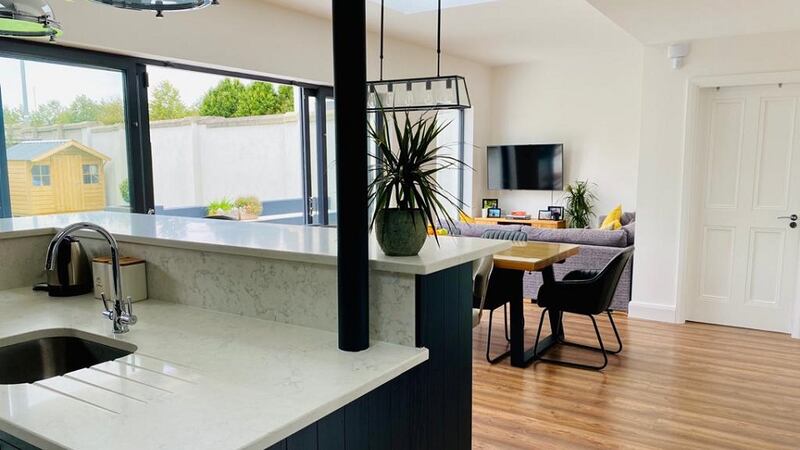
Central to the work was the energy-efficiency upgrade work. “We wanted to future-proof as much as possible,” she says.
With a budget of €180,000, they set about remodelling. Architect Declan drew up the plans and Ivor Gilbert of Wexford Timber Frame Homes was hired as the main contractor. Over 12 months, every room was stripped back, retrofitted, renovated and redecorated.
The whole downstairs layout was reconfigured to accommodate an engineered timber frame extension that wraps the house on two sides – double height at the side and single at the rear.
“We knew the extension was always going to be timber frame. It has excellent U-values and energy efficiency,” says Dervla.
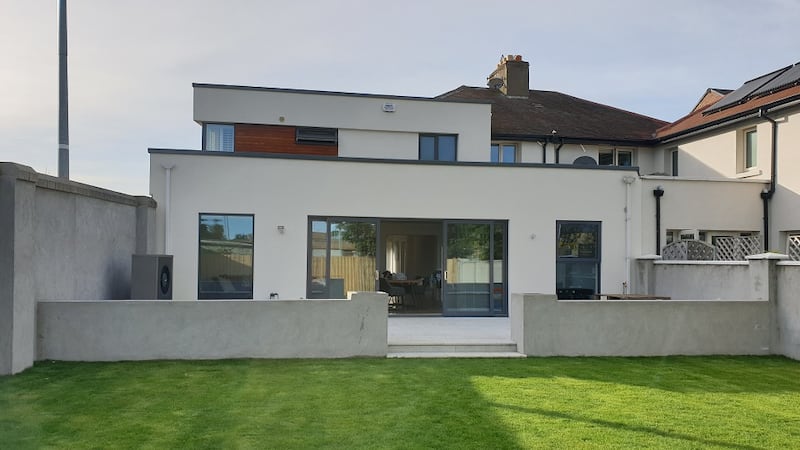
As the couple was keen to include an air to water heat pump, on the advice of their plumber as the best means to provide even heat and low energy bills, the house had to be made airtight. Floorboards throughout the downstairs were taken up and insulated with Kore 153 expanded polystyrene (EPS) and 50mm Xtratherm Polyisocyanurate (PIR), and underfloor heating installed.
The side and rear walls have been externally insulated with 100mm Kore EPS Silver external insulation, while the front of the property has been internally insulated with 73mm Xtratherm PIR warmboard.
“We purposely chose not to externally insulate the front of the house. Because it’s a semi we wanted to retain the pebble dash exterior in keeping with the neighbours,” explains Dervla.
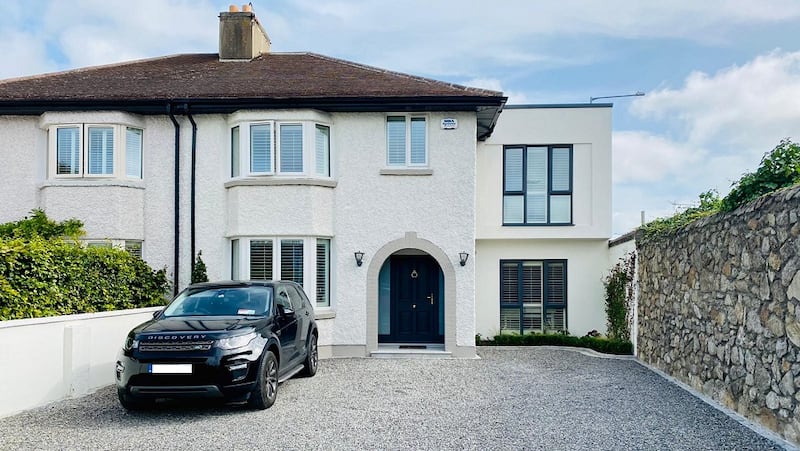
Upstairs in the attic, the floors and eaves have been insulated with Ecocel cellulose – an eco-friendly insulation made from 100 per cent recycled newspaper. “It’s pumped in so it tightly fills every space, which means less heat leaking away,” says Dervla.
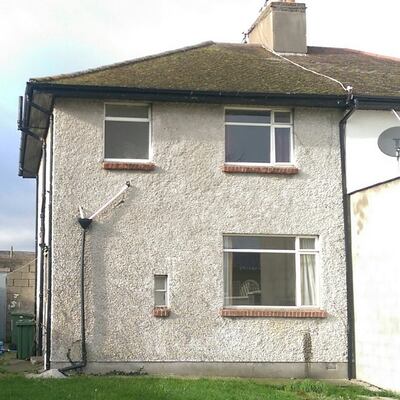
The couple replaced the front door with a passive house standard Prestige hardwood door (with full air tightness, water and draught proof seals) and all the windows throughout are triple glazed Ecotherm aluminium with thermal break technology, from Munster Joinery.
Other airtightness measures undertaken include sealing windows with Siga airtightness membrane and tapes, improving the attic hatches with an airtight seal and sealing around areas where wiring and ducting penetrate the walls. They also replaced the lighting with low energy lighting throughout – a real money saver.
Dervla and Jonathan had hoped to install a mechanical ventilation system but the additional duct work proved too costly. “The upgrade process was more expensive than we had expected so we had to prioritise spend. Hidden extras, like having to install new floors throughout the downstairs, and the cost of heating and plumbing ended up pushing the budget up to €250,000,” she says.
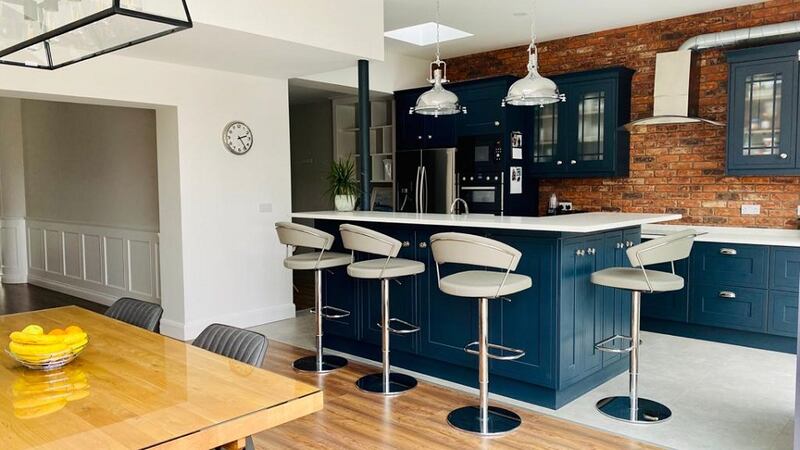
The couple were able to defray some of their costs thanks to tax relief on the improvements under the Government’s now defunct Home Renovation Incentive (HRI) scheme. They also applied for SEAI grants and availed of €300 for attic insulation.
Now that it’s all complete, Dervla and Jonathan, and their two children, DJ, 3, and Zoey, 12 weeks, are very happy in their newly improved home. They’re even considering installing Solar PV in the new few years.
“We had hoped to get the house to an A2 standard, but in the end achieved an A3 because we decided to leave an open fireplace in one of the rooms,” she says. The benefits they’re reaping are enormous. “Having access to hot water on demand has made a big difference to everyday life, especially now we have kids. The house is cosy and warm all the time. We have radiators upstairs, but have never had to turn them on. Best of all, our ESB bill is just €20 to €30 a month,” says Dervla.
Her advice to anyone considering a similar retrofit? “Hire a good architect and contractor. Pick people you can trust, who will listen to you and have your best interests at heart. We were very lucky with Declan and Ivor; they are both really knowledgeable and they cared.”
She also advises pushing the budget out during the renovation stage so you can do every upgrade at once. “If money is tight, weigh up the costs to improve, versus enjoyment and payback.”










